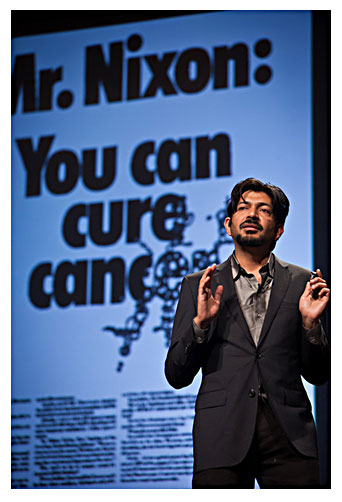Siddhartha Mukherjee clarifies cancer with comparison
If you were … say … a brilliant oncologist and a spectacular writer, and you wanted to tell the story of cancer in a way that people who weren’t brilliant oncologists could understand and enjoy it, what literary tools might you use?

Siddhartha Mukherjee pulls out the stops in The Emperor of All Maladies. He uses storytelling, human interest, wordplay — and some killer etymological insights — to make his biography of cancer fascinating and accessible.
I promise to keep writing about Mukherjee’s book until you beg me to stop. But in the meantime, let’s look at how he uses analogy to make the science of cancer clear and compelling:
‘Like tiny clenched and unclenched fists’
Much of cancer research boils down to observing and reporting. Mukherjee uses analogy to give readers a peek into the microscope:
Analogy is key to good description. Mukherjee uses it to help us see key figures in cancer’s history:
And this analogy helps me envision the dexterity of an early anatomist:
‘A shiver down the hospital’s spine’
In addition to letting us see people, places and things, analogy can also let readers know what something feels like. In this passage, Mukherjee makes emotion tactile through metaphor:
Note how Mukherjee syncs to the subject, elegantly plucking this analogy from the world of medicine and placing it in an emotional landscape:
‘One-eighth the cost of a half gallon of milk’
Comparison is also a great tool for taking the “numb” out of numbers, or making statistics more relevant and interesting. In this passage, Mukherjee’s comparisons dwarf the funds raised for cancer research:
And in this one, he demonstrates how affordable a once-precious medicine became:
‘More perfect versions of ourselves’
Because they compel attention, metaphors add power to your points. In this passage, analogy drives home the point that Mukherjee’s impressive training left him ill equipped for his cancer fellowship:
I know that cancer cells spread quickly. But this analogy makes me think about cell division in a new light:
Mukherjee’s analogy here makes a point beyond familiar hospital gown jokes:
This metaphor makes leukemia vivid …
… as this one makes its destruction clear:
“A monster more insatiable than the guillotine …”
‘Convenience stores for the medieval anatomist’
Sometimes Mukherjee’s analogies are just good for a laugh:
‘The king of terrors’
Several of Emperor’s analogies come from medicine itself. Doctors and researchers developed them as they saw or experienced things they’d never seen or experienced before.
Mukherjee passes them on so the reader, too, can see or experience them in passages like this:
And this:
Finally, of course, the title of the book itself is an analogy. For it, Mukherjee quotes a note a 19th-century surgeon once scribbled about cancer in a book’s frontispiece: “the emperor of all maladies, the king of terrors.”
How can you use metaphor to clarify complex concepts?

Leave a Reply